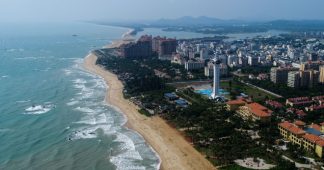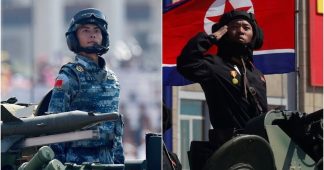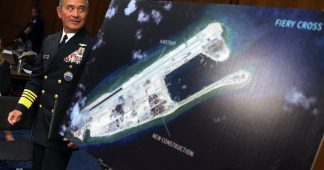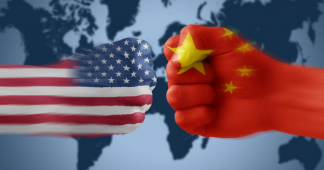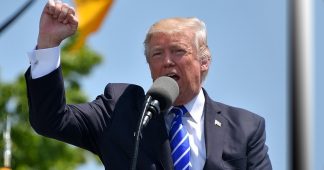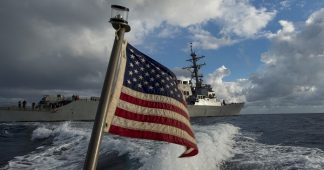Here’s where Washington’s focus will shift to after Syria
By Darius Shahtahmasebi
18 Oct, 2019
Much to Washington’s dismay, China is gaining further momentum in the Indo-Pacific region. As the US president pretends to deploy a hands-off approach to the Middle East, expect China’s gains to fare in the news more often.
The reason the US might be (at least, on the face of it) caring less about the Middle East and the situation in Syria is that Washington has a new priority theater it is allocating its time and resources to focus on: the Indo Pacific. In that vein, you may start to notice that China and its relationship to the Pacific region is starting to make headlines again.
The latest outcry appears to be another kink in a longer chain regarding Beijing’s actions in the Pacific and the wider question of the future of Taiwan. According to reports, China has agreed to fund a multi-million-dollar stadium in the Solomon Islands for the 2023 Pacific Games in its capital, Honiara. Unfortunately, Taiwan had previously made a commitment to providing the funds for the sports complex, but that has all but fallen through. Just recently, the Solomon Islands cut ties with Taiwan in exchange for funding from Beijing ($730 million according to some reports). Kiribati followed suit shortly after, leaving Taiwan with just 15 full diplomatic allies. One would have to think that, given Beijing’s mounting influence and the sorts of packages being offered, that perhaps Tuvalu and the other remaining three Pacific states would not be far behind.
In a bid to bolster support and reassurance for Taiwan, the US, Taiwan and the remaining Pacific Island states held a Pacific Islands Dialogue in Taipei shortly after. Funnily enough, the US called Taiwan a long-time friend of Washington and said they “firmly support Taiwan’s relationship with Pacific Island nations.” It is a bit hard to take the US seriously though, given the official line is that the United States will continue to uphold the “one-China” policy without formally recognising Taipei. Then again, it could just be a matter of time until this is shaken up.
At the same time, a China-Pacific Island economic development and co-operation forum is set to begin this Sunday in the Samoan capital of Apia. Stalwart American ally Australia has “observer status” at the summit, and as you can imagine, is becoming increasingly concerned by China’s recent gains.
Following Beijing’s success in this region over the last few weeks, the government has seen fit to send the third-ranked Vice-Premier Hu Chunua to the forum. As the Australian-based Lowy Institute program director Jonathan Pryke said: “It’s a big deal that such a senior Chinese official is heading to the region, and I would expect him to not come empty-handed.”
Following this visit, the vice premier will then make a trip to the Philippines, another integral member of the Asia-Pacific geopolitical chessboard.
China believes, whether rightly or wrongly, that the world is moving away from an increasingly unpopular unipolar system previously led by the US. While Beijing’s influence is spreading throughout the Middle East, Africa, and even South America, the fastest way to erode American hegemony is more than likely through the Indo-Pacific theater. As China’s defense white paper stated earlier this year, “Asia-Pacific countries are increasingly aware that they are members of a community with shared destiny.”
In other words, a shared destiny which no longer is dictated by the US and its close allies.
As China gets ever closer to this reality, it is understandable that we see further dents arising here and there in China’s armour. The most obvious US-led dent is the US-Sino trade war, which apparently has been resolved by a recent deal (it hasn’t). Other notable mentions are the recent protests in Hong Kong, which the West clearly has lent vocal support to. If China were to support protests in France or even in the United States, you can bet that strong allegations of external interference from a foreign government would arise and China would be condemned for doing so.
Meanwhile, returning to the topic at hand, the New York Times has also just ran a breaking story entitled ‘China Is Leasing an Entire Pacific Island. Its Residents Are Shocked’.
As far as I can see, however, to support its claim, the Times interviewed just one resident.
READ MORE: Not great, not terrible: US tests refurbished missiles after admission nuclear refit lagging behind
Beijing’s recent deal with the South Pacific island of Tulagi came almost immediately following the decision to cut ties with Taipei by the Solomon Islands and Kiribati. According to the Times, the deal includes provisions for a fishery base, an operations center, and “the building or enhancement of the airport.” Essentially, the deal allows the lease of Tulagi and surrounding islands for the development of “a special economic zone or any other industry that is suitable for any development.”
What no one really seems to highlight, however, is that China is not the biggest donor to the Asia-Pacific region.
According to the Lowy Institute, Australia is the leading regional donor, followed closely by New Zealand. China is the region’s third biggest donor, and the United States and Japan are not far behind. In fact, having provided more than $1 billion in aid between 2011 and 2017, the Lowy Institute reckons Japan’s contribution to the Pacific is underappreciated. Yet, no one is up in arms about Japan’s desire to take over the region, debt-trap Pacific island states, or turn the region into a war zone.
Perhaps Japan will never do those things. It does, after all, have a constitution which was supposed to forbid that type of activity (though we know this won’t last forever).
Meanwhile, the US may be (supposedly) withdrawing its troops illegally stationed in Syria, but you can be rest assured that its troops are regrouping and focusing heavily on preparing for a showdown in this region. For one thing, the US Navy tested a new, hard-to-detect and defense-manoeuvring missile in the Pacific as a show of force against China earlier this month. The US is also preparing a 12,000 soldier strong military exercise known as the Defender Pacific, which will see the US work closely with the Philippines, Thailand, Malaysia, Indonesia and Brunei. It could also involve states such as the Marshall Islands and Palau, both still are diplomatic allies of Taiwan.
In the entire region, the US has 85,000 permanently stationed troops in total. It is for this reason that we can start to see a normalisation of media outlets discussing in-depth a hot-war scenario between the US and China. To this day, I am still struggling to find an outlet who is prepared to discuss the ways in which we can avoid such a scenario; not what we can expect to see when the scenario eventuates.
For example, I can’t help but notice that China doesn’t have 85,000 troops stationed in a region close to the United States. China doesn’t regularly flaunt its naval might past the American mainland through freedom of navigation operations; or conduct massive military drills around North America, whether by land or sea. In other words, if a war happens this way, history books will one day be clear about who the aggressor was.
The historically geostrategic importance of a location like Tulagi cannot be overstated. The fate of World War II hung in the balance of the Pacific theater. Still to this day, people fail to realise how significant the region is to powerful nations who seek to control as much of the globe as possible. It shouldn’t take a major war for people to realise this, considering we have already had one.
* Darius Shahtahmasebi is a New Zealand-based legal and political analyst who focuses on US foreign policy in the Middle East, Asia and Pacific region. He is fully qualified as a lawyer in two international jurisdictions.
Published at https://www.rt.com/op-ed/471254-china-pacific-syria-trump-withdrawal/
